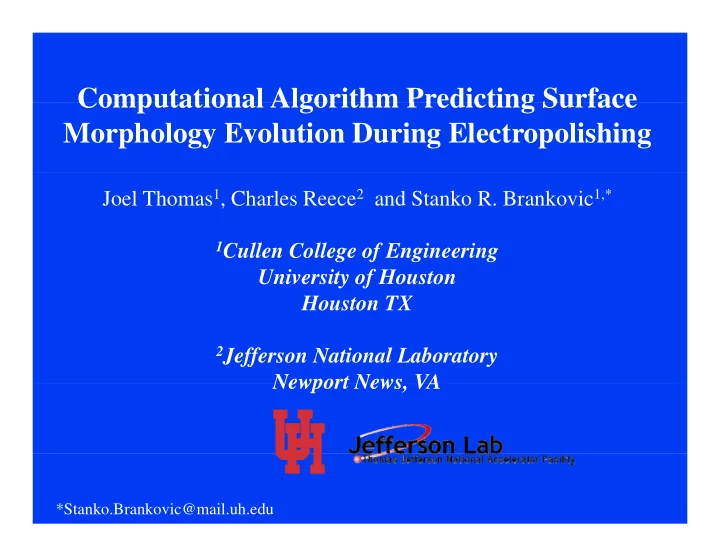

Computational Algorithm Predicting Surface Computational Algorithm Predicting Surface Morphology Evolution During Electropolishing Joel Thomas 1 , Charles Reece 2 and Stanko R. Brankovic 1,* 1 Cullen College of Engineering University of Houston Houston TX 2 Jefferson National Laboratory Newport News VA Newport News, VA *Stanko.Brankovic@mail.uh.edu
Mathematical Theory of Electropolishing t b b ( ( t t ) ) b b exp exp 0 2 j M nF M important : : important b(t) for C. Wagner , J. Electrochem. Soc., 101, 225 (1954). 6 th SRF Materials Workshop www2.egr.uh.edu/~ecnfg Feb. 18-20, 2010 Tallahassee
Scaling Analysis of AFM Data l 1 2 Width w ( l ) [ h ( i ) h ] l l i i 1 1 Surface W w sat Log Log Length Scale Log Length Scale l l c SCALING ANALYSIS : For l l , w ~ l ; C For l l , w w const . C sat *F. Family, T. Vicsek, J. Phys. A 18, L75 (1985). 6 th SRF Materials Workshop www2.egr.uh.edu/~ecnfg Feb. 18-20, 2010 Tallahassee
AFM Results and Discussion for Cu Surface ( ( ) ) 7 7 . 5 5 l l C t const m l C lateral s ize of the grains ( ) ; ( ) ( ) t const t f t S. Shivareddy, S.-E. Bae and S. R. Brankovic , Electrochem. Solid State Lett., 11, 1 (2008). 6 th SRF Materials Workshop www2.egr.uh.edu/~ecnfg Feb. 18-20, 2010 Tallahassee
AFM Results and Discussion for Cu Surface : : : : For For l l l l case case For For l l l l case case C C , , l l l l const t , l l 2 2 1 15 . 5 const l l m C C t ( ) exp w t w 0 6 th SRF Materials Workshop www2.egr.uh.edu/~ecnfg Feb. 18-20, 2010 Tallahassee
Synergy Between Scaling Formalism and Mathematical Theory of Electropolishing Mathematical Theory of Electropolishing Scaling Functions (Electropolishing) ( ( ) ) t Bt 0 0 t ( , ) ( , ) exp 1 w l l t w l l 0 C C 1 1 B B ln( / ) l l C 2 l C t ( , ) ( , ) exp w l l t w l l 0 C C l l 2 2 C C 1 B ln( ln( / / ) ) 0 0 l l a a C 2 l C 1 0 . 00073 B s 6 th SRF Materials Workshop www2.egr.uh.edu/~ecnfg Feb. 18-20, 2010 Tallahassee
Results Analysis: vs. l for l l C and =f(t) B = 0.00058 B = 0.00058 ± ± 0.00008 0.00008 B = 0.00072 ± B = 0.00072 ± 0.00003 0.00003 B’=0 00074 B’=0 00074 ± 0 00008 B =0.00074 B =0.00074 ± 0.00008 0 00008 0.00008 ( ) 1 t Bt 0 1 B ln( / ) l l C 2 2 l l C Theoretical Estimate: B = 0.00073s -1 0 00073 -1 Th ti l E ti t B 6 th SRF Materials Workshop www2.egr.uh.edu/~ecnfg Feb. 18-20, 2010 Tallahassee
Simulation Algorithm for Cu Electropolishing Image (t=0) I (t 0) Algorithm (l C , B, ) Image 2D FFT Image 2D FFT wavelength selection wavelength selection 1 1 2 2 ; l l 2 2 l l l w C l w C 2 1 l B C ln 2 l t C l w ( ) exp b t b 0 2 2 l l t C ( ) exp c t c 0 new data matrix after time t Inverse FFT Image (t) 6 th SRF Materials Workshop www2.egr.uh.edu/~ecnfg Feb. 18-20, 2010 Tallahassee
Simulation Algorithm - Results w w sat f(l, t) f(t) 0.35 0 Sec 0.3 50 Sec 100 Sec 0.25 w sat / m w / m 0.2 0.1 0.15 0.1 1 10 0 20 40 60 80 100 l / m l / m t/ sec t/ t l w ( t ) w ( 0 ) exp C sat sat 2 l l C 5 . 3 m C 1 1 0 0 . 115 115 ms 6 th SRF Materials Workshop www2.egr.uh.edu/~ecnfg Feb. 18-20, 2010 Tallahassee
Simulation Algorithm - Results l C ( t ) const f(t) Bt 0 6.0 0.675 0.675 5.8 Linear Fit 0.670 (Slope = -0.000363) 5.6 0.665 5.4 0.660 l C / m 0.655 5.2 0.650 5.0 0.645 4.8 0.640 4.6 0.635 0 10 20 30 40 50 60 70 80 90 100 0 20 40 60 80 100 t / sec t / sec t / sec l C 5 . 3 m -1 0 . 00038 B s 6 th SRF Materials Workshop www2.egr.uh.edu/~ecnfg Feb. 18-20, 2010 Tallahassee
Real Time Simulations of the Cu Surface Morphology Evolution During Electropolishing Morphology Evolution During Electropolishing (2+1) D surface ( ) 6 th SRF Materials Workshop www2.egr.uh.edu/~ecnfg Feb. 18-20, 2010 Tallahassee
Summary $ • Synergistic combination of scaling analysis and mathematical S i i bi i f li l i d h i l theory of electropolishing yields the scaling functions that can be conveniently used for development of the simulation algorithm predicting surface morphology evolution during electropolishing. l t li hi • The simulation algorithm shod be generally applicable for any electropolishing process including Nb and should help in overall optimization of polishing process (time current etc ) overall optimization of polishing process (time, current, etc..) • The quantitative evaluation of the material preparation/processing and resulting polishing results should be possible using this algorithm. p g g • The quantitative evaluation of current distribution effects (primary and secondary) during electropolishing of Nb SRF cavities should be possible using this algorithm • Polishing of Cu SRF like shape modules/shells and subsequent coating with Nb layer using electrochemical deposition ? 6 th SRF Materials Workshop www2.egr.uh.edu/~ecnfg Feb. 18-20, 2010 Tallahassee
Recommend
More recommend